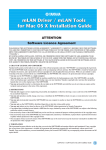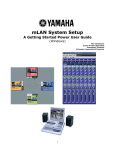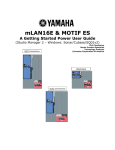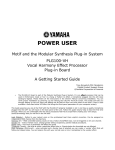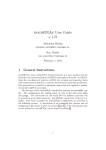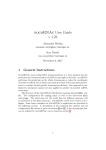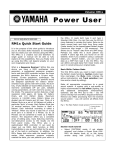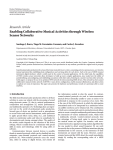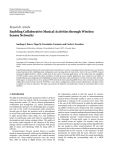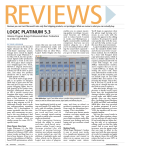Download A Motif ES, mLAN16E, Emagic Logic, and You: A Quick Set
Transcript
y A Motif ES, an mLAN16E, Emagic Logic Software and You A Set Up Guide for Apple OS X Users © 2004, Yamaha Corporation of America 1 y With mLAN now a part of Core Audio and Core MIDI services in Apple OS X, the power of a Motif ES with the mLAN16e card can now be realized with rock solid performance. In this document I am using the following: • • • • A Motif ES 8 (ES OS Version 1.06) with the mLAN16e card installed. It is CRUCIAL that your Motif ES be updated to the most current version! An Apple PowerBook G4, 15 inch, 867 MHz, 1 Gig of RAM, running Apple OS 10.3.5. It is CRUCIAL that your Apple computer be running the latest OS X version, which at the date of this article is 10.3.5. Emagic Logic Platinum Version 6.3.3. I have the latest version of Logic Platinum, which was recently replaced with Logic Pro. They are essentially the same and, as far as mLAN goes, work exactly the same way (as do Gold and Audio version 6.3.1). As long as you are running the most current version of OS X you should be fine. Check www.emagicusa.com for more detailed information on Logic. Current Version of mLAN Tools (Version 1.0.2b) installed. This is available at www.mlancentral.com/drivers.php. A Brief Overview of the mLAN16E in the Motif ES: Before I get started, two things will really help you get your head around a Motif that is mLAN16E-enhanced. To begin with make sure that you have a basic understanding of mLAN. Even if you have some idea of what mLAN is, how it works, and why is cool, if may help you to read up on it at www.mlancentral.com. Also, right here on Motifator is a superb Macromedia Flash presentation on the Motif ES and mLAN16E that will tell you much of what you need to know. Go to www.motifator.com/mart/mainframemlan16e.htm and select “Play the Video”. It is very much worth checking out. Lastly, there is a very useful document at http://www.01xray.com/01xpert/setups/10.3.5_mLAN_V1.0.2b.pdf that, although primarily regarding the O1x, has some great information regarding OS X Audio MIDI set up, mLAN Auto Connector, and other useful things. So what does the mLAN16E do to enhance the Motif ES? Well, so as not to reinvent the wheel, I have cribbed the great Bad Mister’s article, “Getting Started with the Motif ES and the mLAN16e”, located in the “Behind the Manual” section of Motifator (www.motifator.com/es/btm/btmes_index.php). His article is specifically about setting up the Motif ES/mlan16e in Windows XP, but the first part is completely relevant: Music Local Area Network: The Ultimate Expansion Option for Motif ES “mLAN is a digital network for music that was developed based on IEEE1394, an industry-standard high-performance data communications protocol. Digital music environments that do not feature mLAN require dozens of cables for various devices and purposes, including MIDI cables and audio cables to route MIDI and audio signals. If you wish to make changes to such systems, you must physically disconnect and re-connect these cables. For example, adding another synthesizer to a system requires two MIDI cables and two or more cables for audio (for stereo equipment). Making the appropriate connections may require special knowledge of inputs, outputs, stereo settings, and perhaps connector impedance. The larger the system, the more complicated and expensive these connections become, increasing the likelihood of errors and difficulties. It takes time and effort to investigate such errors and their underlying causes. You may have already experienced the unpleasantness of tracking various cables through a spider’s web of connections. mLAN simplifies the physical cable connections by using only one type of IEEE1394 cable, thus © 2004, Yamaha Corporation of America 2 y enabling you to configure extremely sophisticated systems. There is no need to re-patch cables to change routings of MIDI and audio signals between mLAN devices.” What functions does the mLAN16E add to my Motif ES? AUDIO OUTPUTS: The mLAN16E adds fourteen individual audio outputs plus the system’s main stereo L&R output down a single cable for a total of 16 outputs. The question may arise about why do you need the stereo L&R – but of course, you do. It is not always the case that you need individual outputs on everything. Depending on what you are doing, you may only need to take a few PARTS and route them to individual outputs for special processing. The mLAN16E is 14+2 digital outputs. AUDIO INPUTS: The mLAN16E also adds four stereo audio inputs returning from your firewire-equipped computer or other mLAN device down that same single cable (8 inputs). These inputs are referred to as mLAN1 – mLAN4 within the Motif ES. Each represents a pair of inputs. You can route the mLAN input to the System Effects of the Motif ES. This can be useful when monitoring signal during record sessions. You can also route a pair of mLAN inputs to the Motif ES sampler as a digital Source during sample sessions. WORD CLOCK: Word Clock in mLAN world is negotiated automatically – again via the same single cable. Word Clock is a necessity when you are using more than one digital device in a setup. Basically it allows you to make one of the devices the Master clock, and although all your digital devices may be set to run at 44.1kHz (44,100 cycles per second), 48kHz, 88.2kHZ or 96kHz, you need to have them agree on what is a “1” and what is a “0” otherwise you will get these seemingly random clicks and pops (errors). It wasn’t 10 years ago that a multiple word clock interface device would have cost you over a thousand dollars. Clocking multiple devices was extremely expensive. Word Clock negotiation is built in to mLAN. Do not confuse Word Clock Synchronization with MIDI clock or other types of musical synchronization – word clock is all about the zeros and ones of digital data. MIDI IN and OUT PORTS: MIDI is handled on 4 MIDI PORTS. Each Port is a 16-channel communication bus (this is basic MIDI stuff). The port assignments in the Motif ES are as follows: • • • • Port 1: Regular note/performance data and clock timing (16 Channels) Port 2: Can be used for optional PLG Boards or external MIDI devices (up to 16 channels), Port 3: General Remote control functions of Motif ES software (MultiPart Editor for Motif ES 6/7/8 for Windows) Port 4: Specific remote control functions of your computer-based DAW software (Cubase/Nuendo, Sonar, Digital Performer, Logic, SQ01). And again you have just a single cable between your Motif ES and your Computer. Actually the PORT assignment is selectable, except for Port 1, which is fixed as the main communication port for the Motif ES. The other assignments are customizable. When can I use mLAN in my setup? mLAN audio outputs can be assigned anytime you could use the assignable outputs and the main stereo L&R outputs. Therefore in Voice mode signal is always routed to the main L&R outputs – this will be true of the mLAN side of things as well. You cannot route a Voice in Voice mode to an assignable © 2004, Yamaha Corporation of America 3 y output. In Performance Mode and in a Song Mix / Pattern Mix you can route a PART to either the main L&R or any of 14 assignable outputs (as1~as14). mLAN inputs can be assigned anytime you could use the “Audio In” functions. That is, in Performance Mode, or in a Song MIX / Pattern MIX… never in Voice mode. Voice mode has no capability to have external input. In a Performance or Mix you have the option of interfacing the Motif ES (both input and output) with external gear. For example, if you want to plug in a microphone as an AD input to the Motif ES, you would need to be in Performance or Mix. The same is true for mLAN inputs—you have four pairs of audio inputs available during any Performance or Mix. If you want to route a PART out via an assignable output you would need to be in Performance or Mix. The same is true for mLAN outputs. This is not a limitation in any real sense because if you know about your Motif ES, any Voice can be placed in a PART of a Performance. The Performance mode has the ability to store more than just a single Voice – it has the ability to store an Analog-to-Digital (AD) input and it has the ability to route a PART to an assignable output. You will begin to recognize that the mLAN assignments are simply digital domain versions of the analog outputs. In fact, you already know everything in theory that mLAN addresses. It is still simply the same audio and MIDI – just the cabling has been made simpler. There should be no fear of a big learning curve to mLAN – it is simply audio as you have always known it and MIDI as you have always known it but made so that all configurations can be stored and totally recalled whenever necessary. You can maintain the highest quality (24-bit) signal path while routing signal to an mLAN mixer (like the Yamaha 01X) or directly to your computer’s digital audio workstation (DAW) software. mLAN is principally used when the Motif ES is in a multi-timbral/multi-Part mode. This is, in fact, a good way to think about mLAN in your Motif ES: It is a method of interfacing your Motif ES with external inputs and outputs on a per PART basis. There are additional pages added to the Audio Input section when you add the mLAN16E to your Motif ES. There are four pairs of mLAN audio input channels. Incoming signal can be routed through the Motif ES System Effects (for monitoring with effects), Master EQ and Master Effects. What is different about the mLAN16E inputs? There are some differences between the mLAN inputs versus the analog AD inputs. The AD inputs can be routed through the Effects processors of the Motif ES in the following manner: • • • • • You can monitor an AD input with the SYSTEM Effects (Reverb and Chorus processors) You cannot sample the AD input with the SYSTEM Effects, however – the send to the sampler is pre the System Effect. You can route the AD input to its own set of DUAL INSERTION EFFECTS You can record the AD inputs to the sampler with its DUAL INSERTION EFFECTS in tact. The insertion points to/from the Dual Insertion Effects is pre the send to the sampler. So sampling with Insertion Effects is possible. You can route the AD inputs to the Assignable outputs with DUAL INSERTION EFFECTS in tact. This means you can apply Insertion Effects prior to sending signal to the digital audio workstation record track. © 2004, Yamaha Corporation of America 4 y The screen shot above shows the A/D input page – the page you are looking at is indicated in the upper left corner (red arrow). You navigate to this screen as follows: • • • • Press Press Press Press MIXING EDIT COMMON F5 AUDIO IN The mLAN inputs can be routed in the following manner. • • • • • You have the option of applying the SYSTEM Effects (Reverb and Chorus processors) to any mLAN input. This is perfect for a scenario when you are using the Motif ES to create your monitor mix. mLAN inputs can be used to feed a headphone mix when overdubbing to your DAW. Often you want to monitor with reverb but not record it. If you are routing signal via the mLAN inputs you can use the headphone jack of the Motif ES as your headphone rig. You can apply effects to the monitor mix without having to commit to recording those effects to the DAW. You can sample the mLAN input – mLAN can be the source for the sampler unit in the Motif ES. This can be a creative tool when you are flying in some audio clips or combining audio from external sources. You cannot route the mLAN input to the Motif ES DUAL INSERTION EFFECTS directly. However, as you may be aware, you can create a Motif ES USER Voice out of any sample that you create and then you can apply the Dual Insertion Effects. You can route the mLAN input to another mLAN output - sending the signal back again to the DAW. The screen shown below is the “mLAN1” Audio Input screen, which you can view by pressing F5 AUDIO IN from the A/D input page. Remember to read the current screen in the upper left corner. Pressing the SF5 button again will call up the mLAN2 Audio Input screen (shown below): © 2004, Yamaha Corporation of America 5 y Notice that each mLAN input pair has a setting for Volume, Pan, Reverb Send, Chorus Send, Dry Level, Mono/Stereo select, and Output Select. You can monitor the mLAN input with effects and send the signal out to an mLAN output dry. Also added to your Motif ES when you inserted the mLAN16e expansion board is a new screen in the UTILITY area shown here: At F2 I/O> SF2 OUTPUT you will find the extremely important “mLAN Monitor Switch”. What this Switch does is allow you to hear what you are routing out to your digital audio workstation (mLAN Monitor Switch ON) versus what is post the send to the recorder (mLAN Monitor Switch OFF). I like to refer to this as a switch between the scientific output (that which you are sending to your recorder) and the subjective output (that which you are monitoring in your speakers). In a scenario where you are using the Motif ES to add effects to a signal for the purpose of monitoring (subjective)- the mLAN Monitor Switch OFF will let you hear any Reverb you have added to the mLAN signal. Press mLAN Monitor Switch ON and you will hear exactly what is being sent to the record track of your digital audio workstation (the dry signal). Also new is the Assignable Output Gain for the L&R, as1&2, as3&4, as5&6, as7&8, as9&10, as11&12 and as13&14. This will allow you to boost the level of an assignable output when you are attempting to record directly out from the mLAN outputs.”—Phil Clendeninn The mLAN16e has greatly enhanced your already powerful Motif ES. It is now not simply an amazing synthesizer workstation: It also a 16 output/8 input networkable firewire audio interface for you computer. That is both very cool and very unprecedented. Now, let’s set up the Motif ES/mLAN16E to work as a direct MIDI/AUDIO interface to Logic Audio. First, physically connect the mLAN16e firewire port (either one will work) to the firewire port on your Apple computer and in the Motif ES, Under UTILITY/[F5]MIDI/[SF4]OTHER set MIDI IN/OUT to “mLAN” (see below). After this is done you will need to establish an mLAN connection between your MotifES and your computer. Start the program “mLAN Auto Connector” (which I have placed right I my dock so I can get to it easily). Point to “Devices” and you will see your Motif there as long as you have the firewire connected correctly (If you see nothing then it is not physically connected): © 2004, Yamaha Corporation of America 6 y Within Motif ES: Press [UTILITY/[F5]MIDI/[SF4]OTHER and set MIDI IN/OUT to mLAN. Press the [STORE] Button to save this setting. Within the Mac: Start mLAN Auto Connector software, select Devices/Motif ES/Properties. (I have already named my Motif ES 8) Select “Properties” and you will see this screen: Here is where you can name your Motif ES (and it will be remembered, and if your friend comes over with a Motif ES, that one can be uniquely named as well), where you can select the number of stereo input channels returning from your computer to the Motif ES (2, 4, 6, 8 which correspond to mLAN inputs 1-4 in the Motif ES) and where you can set the Word Clock Size (16 or 24-bit). The output channels from the Motif ES to the Mac is fixed at the maximum of 16 total channels (14 individual outputs, 2 channels stereo output) Now select “mLAN Auto Connect and select “Preferences”. This is where you will set your sample rate for the audio that you will record in the Logic. Sample rates of 44.1, 48, 88.2 and 96 kHz are selectable. Which one you want is up to you. The only recommendations I have are consider where you are going to master your audio. Are you burning to a CD when you create your audio master? In that case, 44.1 is probably what you should select unless you are interested in adding the essential step of sample rate conversion to your recording process. Are you burning to DVD? Maybe 96 kHz is better, since DVDs have much more storage space and you can save at the higher fidelity that 96 kHz provides. Keep in mind that the file sizes at 96 kHz are MUCH larger than 44.1. In this scenario I am selecting 44.1, as seen below: © 2004, Yamaha Corporation of America 7 y Now that you have established your connection, let’s take a look at what is going on within the OS X Core Audio and Core MIDI via the OS X Audio MIDI Setup utility. If you don’t already know this, this application exists within the Mac’s Utility Folder (and a shortcut to this app sits in my Dock). That actual content of devices in you doc may look different than what appears below if you have other devices with different drivers. I have set up specifically for the Motif ES-mLAN16e: Select the “MIDI Devices” button: The Motif ES-mLAN16 appears as an 8 Port MIDI Device, but don’t be confused: As stated above, just the first 4 Ports are the ones that are active and will be seen by Logic. © 2004, Yamaha Corporation of America 8 y Select the “Audio Devices” Button: Here you can view the audio properties for the Motif ESmLAN16e. Notice that they correspond to what was setup in mLAN Auto Connector: 44.1 Sample Rate, 24 bit resolution, 16 Channels input (Motif ESÆMac: 14 Individual Outs + 2 Channel Stereo Out = 16), 8 Channel Output (MacÆMotif ES: These are the 4 stereo channels that appear as mLAN1-4 within the Motif ES under MIX/EDIT/F5:AUDIO IN). The fader/channel information below is not active—These settings are edited within Logic and the Motif ES. Now that you have the mLAN connection established and viewed what is happening within Core Audio and Core MIDI, you can launch Logic and get things configured there. Once you have Logic up and running, select “Preferences—Audio Hardware and Drivers” and, under “Driver”, make sure the “mLAN Network” is selected. See the graphic below: Preferences/Audio Hardware and Drivers: Note that Core Audio is checked and the driver is mLAN Network. Audio communication is taking place there. The “I/O Buffer Size” is a very important thing to understand since this affects audio performance and latency. A lower buffer size (such as what I have selected here) insures a very low latency. If most of your work is MIDI oriented, I recommend working at low latency. If you are using more audio, try the lower latency first. If you get some odd behavior, any strange audio anomalies such as clicks or pops, try increasing the latency. You will have to reboot every time you change that number. © 2004, Yamaha Corporation of America 9 y So how does my set up look? Below is a view of my Arrange window with an Environment window showing my MIDI set up: Audio Tracks: Currently I have 8 in my setup, but I can as many tracks as necessary. AudioInst: There are specific tracks for any Software Synth Plug-ins. Environment Window: I show this so you can see what my environment looks like. SIMPLE is the word for it: If I had more devices I would add them. Try to streamline your system as much as possible. MIDI Tracks: These are my sequence tracks, labeled “Motif ES-MLAN16E X” where “X” is the channel number that correspond with my Motif ES Mix Parts Let’s take a close look at the Environment within Logic. Environments are fluid, objectoriented customizable setups in Logic that are really the heart of the system. Two places that are important to look at and understand is the Midi Instrument view and the Clicks and Ports view. Most of problems I see people have with Logic are usually related to a setting in this window. First let’s open an Environment window by selecting “Windows/Open Environment” and look at my Midi Instrument set up in greater detail: Environment Window, Close Up: As you can see, I have named a Multi Instrument “Motif ES-MLAN16E” to correspond with my ES and it is assigned to “Plug 1” which we call Port 1 in the ES. Remember—Port 1 is where the internal ES synthesizer communicates over mLAN for all 16 parts. Port 2 is for Modular Synthesis Plug-in PLG 150 card communication and can be set for a second 16-channel, standard MIDI port tone generator like the Motif Rack multitimbral tone generator, Port 3 is general remote for the Windows-based Motif ES software editor and Port 4 is dedicated to Software Control (more on that below…). NOTE: Logic has very cool screen set functions whereby you can open windows, save snapshots of several different windows on a single screen (like and arrange window, environment window and event list window in a single screen) with user defined key commands. It is a worthy skill to master. Look in you Logic Manual for more details about creating custom screen sets. © 2004, Yamaha Corporation of America 10 y Environment Window, Close Up Part 2: Let’s say that you have an external keyboard or tone generator that is not mLAN compatible but does have standard MIDI ports and you want to bring this device into your mLAN network. It is easily done in the following way: On the Motif ES: Go to UTILITY/[F5]MIDI/[SF4]1. OTHER. This is where we already set MIDI IN/OUT to mLAN. 2. Where it says “ThruPort” Select 2. Press the [STORE] button directly beneath the [UTILITY] button to save this setting (see below). 3. Connect your external device to the MIDI ports on the back of the Motif ES and set your device to it’s multitimbral mode if needed. In Logic: In your environment window, create a 4. second Multi Inst and in the properties window to the left, select “Plug 2” So there’s my environment. Let’s look at the “Clicks and Ports” window now: Clicks and Ports: Logic can handle 64 physical, 16-channel MIDI ports. With the Motif ES/mLAN16e, there are really only 2 ports that need to be connected in this window: Port 1, which is the Motif ES internal tone generator, and, if you are using Plug-in cards or a second tone generator, Port 2. Port 3 should not be connected because it is not in use (General Remote—usually assigned to the Motif ES Windows XP editor) and Port 4 is in use for Logic Control (more on this below). Understanding this graphic is really a matter of following the Physical Input routing: Inputs 1 and 2 to the virtual keyboard, then to the input view meter that shows realtime MIDI data, then to the “to Recording & Thru” icon which represents Logic’s sequencing engine. Unless you have other gear you needn’t connect any other ports. The last thing to show is the Remote Control set up. This is yet another extremely cool feature on of the Motif ES: It is can work as a remote control surface for Logic. What you get is functionality that is on par with expensive stand-alone control surfaces, and it works great. Check out the screen below, which I called up by selecting "Logic Platinum/Preferences/Control Surfaces/Setup”: © 2004, Yamaha Corporation of America 11 y Control Surface: Here is my set up screen for setting up my Motif ES as a control surface. As previously noted, software control data is transmitted over mLAN on Plug 4. In order for this to all work, you must set the Motif ES to Logic under UTILITY/[F4]CTLASN[SF4]REMOTE, set remote to Logic on Port 4 and press the [STORE] button (see below). Once this is set in the Motif ES Logic usually finds this automatically upon launch since it takes information about the device from Apple Core MIDI services, which in turn takes its information from the mLAN driver. I have never had it not automatically find my Motif ES and identify it as an available control surface. If nothing shows up when you select Control Surface Setup, try selecting “Logic/Preferences/Control Surfaces/Scan” and allow logic to scan for control surfaces. If nothing appears there is an error in connection, and it will most likely mean that things are not connected in other places (like MIDI and Audio). The one rule of thumb when configuring hardware and software is when adding devices, reconfiguring things, etc., you will always have to tweak you system for optimal performance. This is probably the biggest technical support issue that manufacturers of both hardware and software deal with the most. Almost everyone’s problems have to do with incorrect configurations within their personal setups. Furthermore, every computer is completely different: Making sure yours is running at optimal performance, dealing with software or driver issues, keeping things as SIMPLE as possible, and other factors are essential in getting your mLAN system up and running and working well. The 3rd item in the previous sentence— that of simplicity—is, to me, the key to getting the most out of your mLAN/Logic system. The last recommendation I have is EXPERIMENT as much as possible with your system before diving into a serious project. There are SO many options with a Motif ES, mLAN and Logic. Mess around with settings, sequence some tracks, record some audio, etc., and get things set up for the way YOU want to work before you do something that requires your CREATIVITY. The one thing that is exceptionally frustrating when working with hardware/software setups is troubleshooting while attempting to remain in a creative headspace. Make the trips back and forth across your corpus callosum for the sake of creativity. In other words, get your technical stuff together so you can use your brainpower to make something artful. Blake Angelos Product Specialist Product Support Group Yamaha Corporation of America © 2004, Yamaha Corporation of America 12












